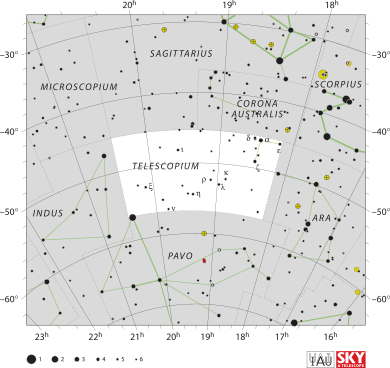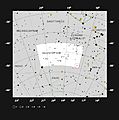Telescopium facts for kids
| Constellation | |

List of stars in Telescopium
|
|
| Abbreviation | Tel |
|---|---|
| Genitive | Telescopii |
| Pronunciation | genitive |
| Symbolism | the Telescope |
| Right ascension | 19 |
| Declination | −50 |
| Quadrant | SQ4 |
| Area | 252 sq. deg. (57th) |
| Main stars | 2 |
| Bayer/Flamsteed stars |
13 |
| Stars with planets | 0 |
| Stars brighter than 3.00m | 0 |
| Stars within 10.00 pc (32.62 ly) | 2 |
| Brightest star | α Tel (3.49m) |
| Messier objects | none |
| Bordering constellations |
Ara Corona Australis Indus Microscopium (corner) Pavo Sagittarius |
| Visible at latitudes between +40° and −90°. Best visible at 21:00 (9 p.m.) during the month of August. |
|
Telescopium is a small constellation located in the southern sky. Its name comes from the Latin word for "telescope." This constellation was created by a French astronomer named Nicolas-Louis de Lacaille in the 1700s. He named it to honor the invention of the telescope, which was a very important tool for studying the stars.
Contents
What is Telescopium?
Telescopium is one of the many constellations that make up our night sky. It is not very bright, so it can be a bit tricky to find. It sits near other constellations like Sagittarius and Corona Australis. You can best see it in August.
Where is Telescopium located?
Telescopium is in the fourth quadrant of the southern hemisphere. This means it is visible from places south of the 40th parallel north. It cannot be seen from most of the Northern Hemisphere.
Stars in Telescopium
Even though Telescopium is small, it has some interesting stars. The brightest star in this constellation is called Alpha Telescopii. It is a blue-white star that is much hotter and bigger than our Sun.
Alpha Telescopii
Alpha Telescopii shines with a magnitude of 3.49. This star is about 278 light-years away from Earth. It is a giant star, meaning it is much larger than our Sun.
Other notable stars
Another interesting star system in Telescopium is called HR 6819. Scientists recently found that this system might contain a black hole. A black hole is a place in space where gravity pulls so much that even light cannot get out.
Deep-sky objects
Besides stars, Telescopium also contains some fascinating deep-sky objects. These are objects that are not single stars, like galaxies or star clusters.
NGC 6845 galaxy system
One example is NGC 6845. This is a group of four galaxies that are interacting with each other. Interacting galaxies are those that are close enough to affect each other through gravity. They can even merge over billions of years.
History of Telescopium
Nicolas-Louis de Lacaille created Telescopium during his trip to the Cape of Good Hope. He observed the southern sky from 1750 to 1754. He named many new constellations after scientific instruments.
Lacaille's constellations
Lacaille named 14 constellations after tools. These included the Air Pump (Antlia), the Compass (Circinus), and the Microscope (Microscopium). He wanted to honor the tools that helped advance science.
Images for kids
-
An artist's depiction of the orbits of the hierarchical triple star system HR 6819, with the inferred black hole (red orbit) in the inner binary
See also
 In Spanish: Telescopium para niños
In Spanish: Telescopium para niños





